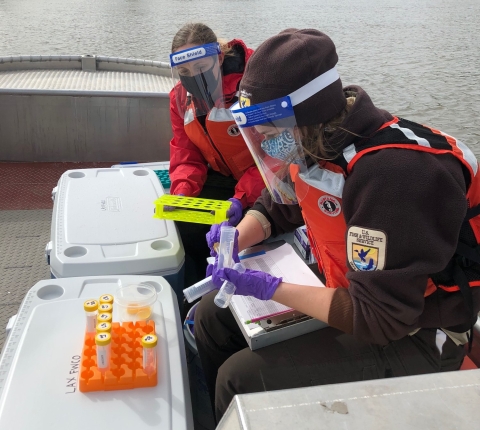What We Do
Invasive Carp eDNA Monitoring Program
eDNA for Invasive Carp Early Detection
eDNA is used as an early detection tool because it is more sensitive than other methods (netting, electrofishing, etc.) at detecting low populations of bighead and silver carp. Water samples can be taken from just about anywhere. This allows for more area to be covered with minimal effort compared to labor and equipment intensive traditional monitoring.
What’s the problem with Invasive Carp in the Water?
Silver and bighead carp are filter feeders of plankton, algae, and other microscopic organisms and can consume between 5-20% of their body weight daily. This aggressive feeding harms young native fish by reducing the food available and reducing habitat cover. The decline in native fish could result in less biodiversity and fish to harvest by sport and commercial fishers.
Silver carp are disturbed by the sound of boat and jet ski motors, and are known to jump up to 10 feet out of the water when a boat or moving watercraft passes by. This can result in injuries to people and personal property. Due to the harm invasive carp can inflict, there is a large ongoing effort to keep invasive carp out of the Great Lakes System. The Great Lakes directly generate more than 1.5 million jobs and recreational activities such as boating, hunting, and fishing generate more than $52 billion annually for the region.
What is eDNA?
Environmental DNA (eDNA) is genetic material like hair, skin and bodily fluids that can be taken from the environment. In this case, water samples are taken from river systems to see if bighead and silver carp eDNA can be found.
How is eDNA used to detect Carp?
Water samples are tested for the presence of invasive carp eDNA at the Whitney Genetics Lab in Onalaska, Wisconsin. Genetic markers that are unique to silver and bighead carp are used to identify if the water samples contain invasive carp DNA.
eDNA for Threatened and Endangered Species
Staff at the Whitney Genetics Lab are working towards using eDNA markers to identify native species. Currently, we are working on markers for the Wood turtle and Topeka shiner. The use of eDNA can aid in the detection of species that may be hard to collect. It is also a useful tool that can cut down on time and resources if physical sampling is difficult.
Genetic Surveillance of Invasive Species using Metabarcoding
The Whitney Genetics Lab and Northeast Fishery Center are partnering to utilize large-scale metabarcoding as another method in the Great Lakes Early Detection and Monitoring program. This initiative is designed to improve the efficiency of the U.S. Fish and Wildlife Service to detect aquatic invasive species invasive species
An invasive species is any plant or animal that has spread or been introduced into a new area where they are, or could, cause harm to the environment, economy, or human, animal, or plant health. Their unwelcome presence can destroy ecosystems and cost millions of dollars.
Learn more about invasive species early in a potential invasion.
Our Projects and Research
Environmental DNA
The Whitney Genetics Laboratory processes environmental DNA (eDNA) samples from multiple watersheds.
Read the Quality Assurance Project Plan (QAPP)
Bighead and Silver Carp Environmental DNA Monitoring Data
Find the latest data on bighead and silver carp monitoring.






